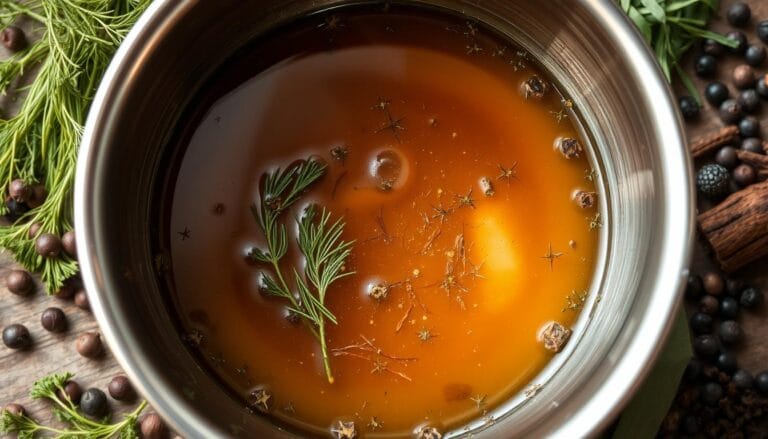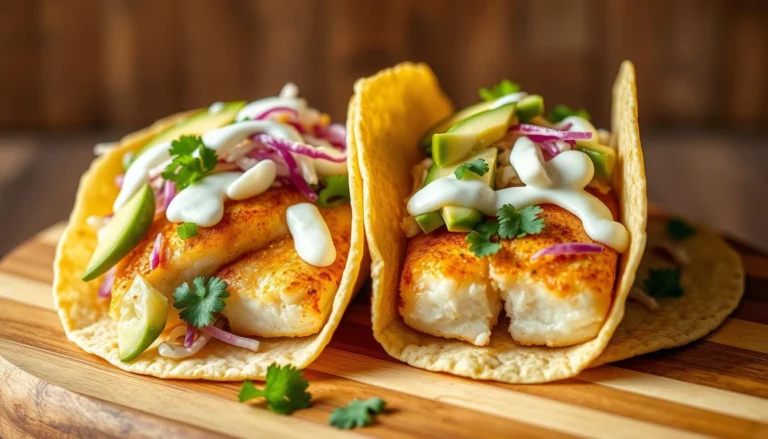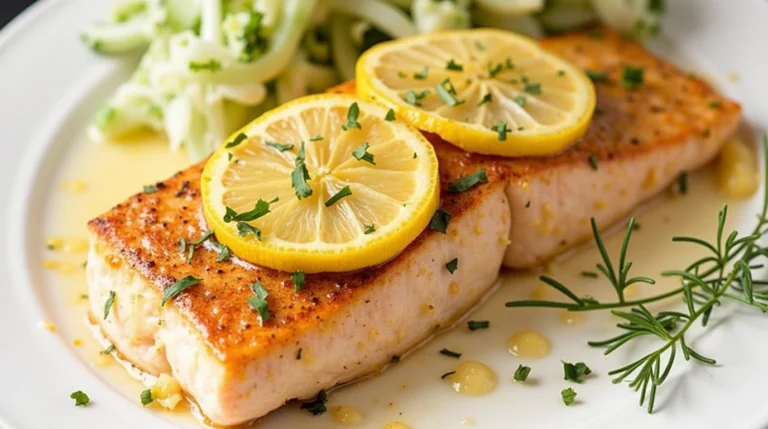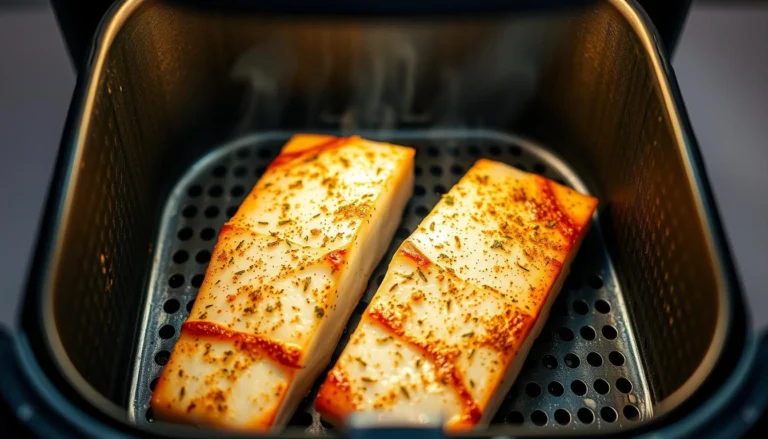Delicious Ahi Tuna Recipe – No Seare

Table of Contents
Imagine turning a simple piece of fresh ahi tuna into a culinary masterpiece without a hot pan. The art of making an ahi tuna recipe without searing brings out vibrant flavors and textures. It will excite your taste buds. Whether you’re a home cook or a seafood lover, this no-sear ahi tuna recipe offers an unforgettable dining experience.
Raw preparation is more than just a cooking method—it’s a celebration of the fish’s natural qualities. Premium ahi tuna has a buttery texture and a clean, ocean-fresh taste. Our guide will show you how to pick the best tuna, prepare it safely, and make dishes that are bursting with flavor.
Key Takeaways
- Learn a professional-level no-sear ahi tuna recipe technique
- Discover how to select the highest quality tuna
- Explore safe raw fish preparation methods
- Create restaurant-style dishes at home
- Understand flavor enhancement techniques
Understanding Ahi Tuna: Quality Selection and Safety
Choosing the right ahi tuna is key to a tasty and safe dish. It’s about knowing what makes top-quality fish stand out. This knowledge is crucial for a successful raw tuna dish.
Finding the best tuna starts with knowing what to look for. It’s not just about how it looks. It’s about the details that make it great.
How to Identify Sushi-Grade Tuna
Not all tuna is the same. When picking fish for raw dishes, keep these points in mind:
- Buy from trusted seafood markets
- Look for sushi-grade labels
- Make sure it’s been flash-frozen
- Check for a bright, vibrant color
Color and Texture Indicators
Good ahi tuna for sashimi has certain looks:
- It should be a deep red or pink
- It should feel firm and smooth
- It should not have brown or gray spots
- It should have little visible fat
“The quality of your tuna crudo is directly proportional to the care taken in selection.” – Professional Chef’s Seafood Guide
Safe Handling Practices
Keeping tuna safe is important for your health. Always keep it cold, use clean tools, and eat it right away. This helps avoid risks.
- Keep tuna refrigerated at 40°F or below
- Use sanitized cutting tools
- Eat within 24 hours of buying
- Avoid mixing it with other foods
Essential Kitchen Tools for No-Sear Ahi Tuna Preparation
Preparing a delicious ahi tuna recipe needs the right tools. Both professional chefs and home cooks know quality equipment makes a big difference. When working with raw ahi tuna, being precise and clean is key.
Your essential toolkit for ahi tuna preparation should include:
- Sharp Sashimi Knife: A high-quality, razor-sharp blade ensures clean, precise cuts for your ahi tuna recipe
- Cutting Board: Preferably a dedicated board for raw fish to prevent cross-contamination
- Ceramic or Glass Plate: Ideal for serving raw tuna dishes
- Digital Kitchen Scale: For precise measurements
- Chilled Serving Platter: Keeps your ahi tuna at the perfect temperature
Specialized equipment can make your ahi tuna recipe stand out. Think about getting:
- Professional-grade fish tweezers for delicate garnishing
- Mandoline slicer for uniform, thin cuts
- Microplane grater for zesting citrus garnishes
Remember, cleanliness is crucial when preparing raw fish. Always sanitize your tools before and after use. Keep your workspace clean to ensure food safety with your ahi tuna recipe.
Key Ingredients for Perfect Raw Ahi Tuna
Making a great sesame crusted ahi tuna dish starts with picking the right ingredients. These ingredients boost the fish’s taste and texture. It’s all about choosing the best parts to make your dish stand out.
The right mix of seasonings and fresh ingredients can make your sesame crusted ahi tuna taste like it’s from a fancy restaurant. Let’s look at the key elements that will make your dish unforgettable.
Asian-Inspired Seasonings
Asian flavors are perfect for enhancing your ahi tuna. Here are the must-have seasonings:
- Toasted sesame seeds
- Wasabi powder
- White and black pepper
- Sea salt
- Shichimi togarashi (Japanese seven-spice blend)
Fresh Herbs and Aromatics
Fresh herbs add a burst of flavor to your sesame crusted ahi tuna. Pick from these aromatic options:
- Cilantro
- Green onions
- Fresh ginger
- Lemongrass
- Thai basil
Sauce Components
A great sauce can take your ahi tuna to the next level. Here are some sauce ingredients to consider:
| Base | Flavor Enhancers | Heat Elements |
|---|---|---|
| Soy sauce | Rice vinegar | Sriracha |
| Ponzu | Sesame oil | Chili garlic sauce |
| Mirin | Lime juice | Wasabi paste |
By choosing and mixing these ingredients well, you’ll make a sesame crusted ahi tuna dish that’s a real treat. It will take your taste buds on a journey to new heights.
Basic Ahi Tuna Recipe – No Sear
Making a tasty ahi tuna recipe without searing is simple. This method lets you enjoy the tuna’s fresh taste and soft texture.
To begin your no-sear ahi tuna recipe, gather these key ingredients:
- Sushi-grade ahi tuna
- Sesame oil
- Sea salt
- Fresh cracked black pepper
- Optional: Soy sauce or ponzu
Start by picking the freshest ahi tuna you can find. This is key for a raw dish. Use a sharp knife to cut the tuna into thin slices, about 1/4 inch thick.
Season the tuna with sesame oil, sea salt, and black pepper. This brings out the tuna’s natural flavors. For a traditional touch, serve with soy sauce or ponzu for dipping.
Pro tip: Always use sushi-grade tuna and keep it chilled before serving to ensure food safety.
Your no-sear ahi tuna recipe is ready to wow – a dish fit for a restaurant, made easily in your kitchen!
Marinade Options for Enhanced Flavor
Choosing the right marinade is key to making your ahi tuna tataki stand out. Marinades add flavor, tenderize the fish, and highlight its natural taste. It’s all about finding the right mix that complements the fish’s delicate flavor.
When making ahi tuna tataki, pick marinades that enhance the fish’s premium taste. The right flavors can turn a simple dish into a masterpiece.
Citrus-Based Marinades
Citrus marinades offer a fresh, zesty twist to ahi tuna tataki. They “cook” the fish gently and add a burst of citrus flavor.
- Lime and ginger blend
- Orange and ponzu combination
- Yuzu-based marinade
Soy-Based Variations
Soy marinades bring a deep umami flavor that pairs well with ahi tuna. They add a rich, complex taste to your dish.
| Marinade Type | Key Ingredients | Flavor Profile |
|---|---|---|
| Classic Shoyu | Soy sauce, mirin, sake | Deep, traditional Japanese |
| Teriyaki-Inspired | Soy sauce, brown sugar, garlic | Sweet and savory |
Spicy Asian Blends
For a bold twist, try spicy Asian marinades. They turn your ahi tuna tataki into a memorable dish.
“The right marinade can turn a simple piece of fish into a memorable meal.” – Professional Chef
- Sriracha and sesame oil mix
- Chili garlic sauce
- Korean gochujang-based marinade
Remember, the secret to a great ahi tuna tataki marinade is balance. Try different mixes to find your favorite flavor.
Creating the Perfect Tuna Tartare
Making a great tuna tartare needs care and creativity. Start by picking the best sushi-grade tuna. It’s all about keeping the fish’s soft texture and boosting its taste.
First, choose fresh ahi tuna with a bright, deep red color. The fish’s quality is key to a tasty tartare. Cut the tuna into small, uniform cubes, about 1/4 inch each.
- Select sushi-grade ahi tuna
- Use a sharp, clean knife
- Maintain consistent cube size
- Keep tuna cold during preparation
Seasoning is vital for a great tuna tartare. Here are some classic ways to season:
| Seasoning Style | Key Ingredients | Flavor Profile |
|---|---|---|
| Classic Asian | Soy sauce, sesame oil, ginger | Umami-rich, bright |
| Mediterranean | Olive oil, lemon, herbs | Fresh, citrusy |
| Spicy | Sriracha, chili oil, wasabi | Bold, intense heat |
For a fancy look, shape your tuna tartare in a ring mold. Top it with microgreens, toasted sesame seeds, or olive oil. Serve it right away to keep the tuna’s texture and taste fresh.
Transform Your Tuna into a Hawaiian Poke Bowl
Learn how to make a real ahi poke bowl right in your kitchen. This dish turns raw ahi tuna into a tasty and healthy meal. It’s loved by many in the United States.
Poke bowls have grown from a Hawaiian street food to a trendy dish. Your ahi poke bowl mixes fresh ingredients with bold flavors. It celebrates Pacific Island cuisine.
Traditional Poke Seasonings
To get the true Hawaiian ahi poke bowl taste, use these seasonings:
- Sea salt
- Soy sauce
- Sesame oil
- Green onions
- Crushed red pepper flakes
Building Your Bowl
Building the perfect ahi poke bowl is all about layers. Start with:
- Sushi rice
- Mixed greens
- Cauliflower rice
Then, add cubed raw ahi tuna seasoned with Hawaiian flavors. Top it with cucumber, avocado, and edamame. This makes your ahi poke bowl complete.
Fresh Tuna Ceviche Mediterranean Style
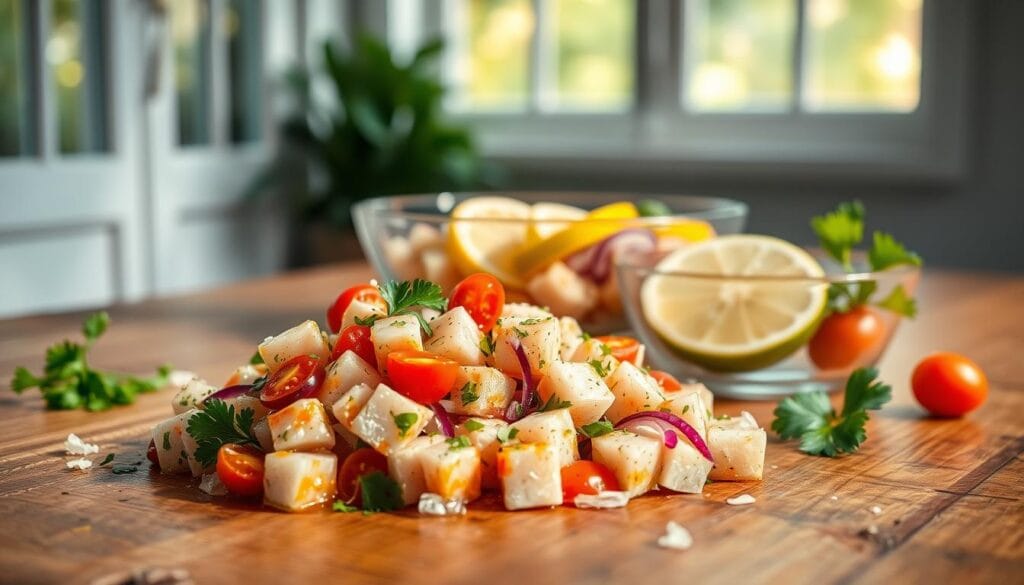
Learn to make a Mediterranean twist on tuna ceviche. This dish turns raw ahi tuna into a refreshing treat. It captures the essence of coastal cuisine with a unique flavor.
To make great tuna ceviche, choose the right ingredients and technique. Use ultra-fresh, sushi-grade tuna that’s safe to eat raw. Your Mediterranean version will add flavors from the region’s rich food heritage.
- Select premium ahi tuna with deep red color
- Use fresh citrus for acid-based marination
- Incorporate Mediterranean herbs like oregano and mint
- Choose high-quality olive oil
The secret of tuna ceviche is its simple making. Raw tuna is “cooked” by citrus acids, making it tender and flavorful. Mediterranean versions often add:
- Kalamata olives
- Diced cucumber
- Crumbled feta cheese
- Chopped parsley
“Fresh ingredients are the soul of Mediterranean cooking” – Mediterranean Culinary Tradition
Your tuna ceviche will be a stunning appetizer or light main course. It highlights the delicate flavors of fresh ahi tuna and Mediterranean traditions.
Plating Techniques for Restaurant-Quality Presentation
Turning your ahi tuna sashimi into a masterpiece starts with how it looks. Chefs know that the eyes are the first to taste. So, plating is key for both home cooks and pros.
Visual appeal is as important as taste when making ahi tuna sashimi. You want your plate to look as good as it tastes.
Strategic Garnishing Approaches
Boost your ahi tuna’s look with these garnishing tips:
- Use microgreens for delicate texture
- Sprinkle sesame seeds for contrast
- Add edible flowers for color pop
- Create artistic sauce drizzles
Color Composition Principles
Color is key to making your ahi tuna sashimi pop. Here are some color pairing tips:
| Color Group | Complementary Ingredients |
|---|---|
| Green Tones | Wasabi, cucumber, shiso leaves |
| Red Accents | Pickled ginger, radish slices |
| White Highlights | Daikon radish, white sesame |
“Plate like an artist, serve like a chef” – Culinary Wisdom
To achieve top-notch ahi tuna sashimi presentation, balance colors, textures, and space on your plate.
Complementary Side Dishes and Accompaniments
Choosing the right side dishes can make your raw tuna salad stand out. The perfect sides can turn a simple dish into a feast for the senses. Your aim is to create a meal that showcases the fresh ahi tuna’s flavor.
Here are some side dishes that go well with raw tuna salad:
- Light Asian-inspired cucumber salad
- Crisp mixed green salad with citrus vinaigrette
- Seaweed wakame salad
- Pickled vegetable medley
- Steamed edamame with sea salt
Texture is key to a great dining experience. Sides like pickled daikon radish or toasted rice crackers add a nice crunch. Look for sides that offer different temperatures and textures to keep things exciting.
If you prefer something more filling, try these options:
- Coconut jasmine rice
- Quinoa with roasted vegetables
- Crispy wonton chips
- Avocado and mango salsa
Your raw tuna salad can be the star of the show. Mix and match these sides to make a meal that’s just right for you.
Storage and Food Safety Guidelines
Proper storage is key when making a raw ahi tuna recipe. It keeps you safe from health risks and keeps the tuna’s flavor and texture fresh.
Raw ahi tuna needs careful handling to stay good and prevent bacteria. How you store it can make your dish a hit or a miss.
Critical Temperature Control
Keeping your ahi tuna at the right temperature is crucial for safety. Here are some important tips:
- Refrigerate raw tuna right after buying it
- Keep the fridge at 40°F or colder
- Put tuna in the coldest spot in your fridge
- Use a sealed container or wrap it tightly in plastic wrap
Maximum Storage Time Recommendations
Knowing how long to store tuna is key to avoiding foodborne illnesses:
- Fresh raw tuna: 1-2 days max in the fridge
- Throw it away if it smells off
- Check for any signs of spoilage before cooking
If you’re unsure about your tuna’s freshness, it’s best to throw it away. Your health is worth more than saving money.
Conclusion
Exploring no-sear ahi tuna recipes opens up a world of simple yet elegant dishes. Your kitchen can become a gourmet spot with just a few quality ingredients and the right techniques. The secret to success is choosing premium sushi-grade tuna and mastering the art of raw fish.
Each recipe, from classic tartare to vibrant Hawaiian poke bowls, shows how versatile ahi tuna is. You’ll gain confidence in your cooking with marinades, seasoning, and presentation. Remember, the quality of your ingredients matters, so choose fresh, high-grade tuna from trusted sources.
We encourage you to try these no-sear ahi tuna techniques and make restaurant-quality meals at home. Your culinary journey is just starting—share your dishes, learn from your experiences, and keep exploring raw fish preparation. Food is about connection, creativity, and enjoying the process of making something delicious.
Begin your ahi tuna recipe journey today and enjoy making fresh, flavorful dishes that will wow your family and friends. Your kitchen is now your playground for culinary innovation.


